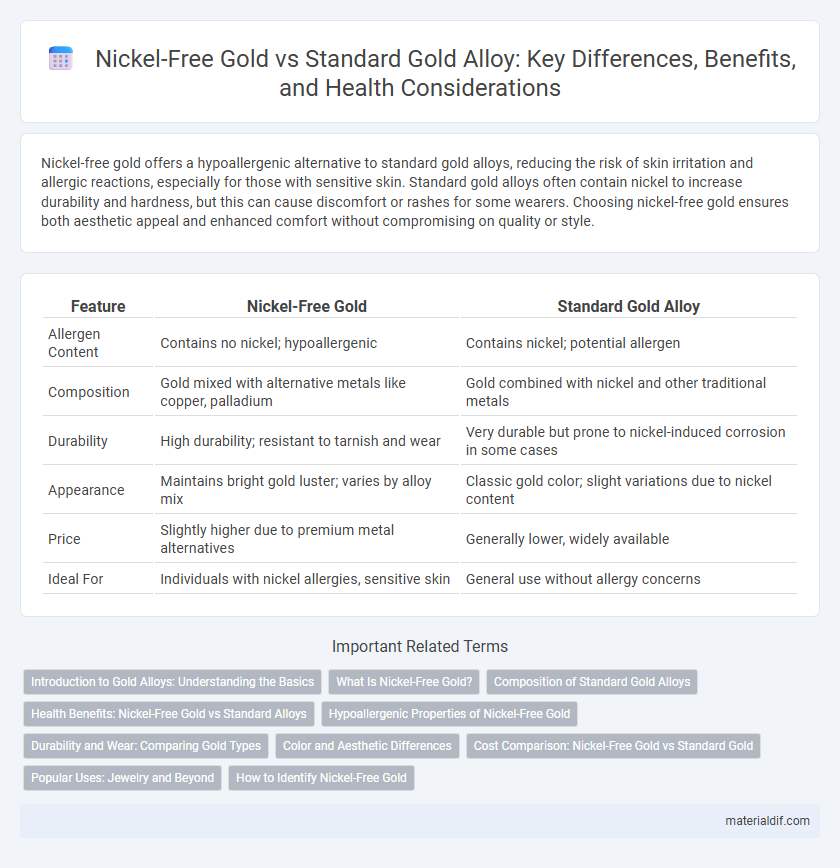Nickel-free gold offers a hypoallergenic alternative to standard gold alloys, reducing the risk of skin irritation and allergic reactions, especially for those with sensitive skin. Standard gold alloys often contain nickel to increase durability and hardness, but this can cause discomfort or rashes for some wearers. Choosing nickel-free gold ensures both aesthetic appeal and enhanced comfort without compromising on quality or style.
Table of Comparison
| Feature | Nickel-Free Gold | Standard Gold Alloy |
|---|---|---|
| Allergen Content | Contains no nickel; hypoallergenic | Contains nickel; potential allergen |
| Composition | Gold mixed with alternative metals like copper, palladium | Gold combined with nickel and other traditional metals |
| Durability | High durability; resistant to tarnish and wear | Very durable but prone to nickel-induced corrosion in some cases |
| Appearance | Maintains bright gold luster; varies by alloy mix | Classic gold color; slight variations due to nickel content |
| Price | Slightly higher due to premium metal alternatives | Generally lower, widely available |
| Ideal For | Individuals with nickel allergies, sensitive skin | General use without allergy concerns |
Introduction to Gold Alloys: Understanding the Basics
Gold alloys are created by mixing pure gold with other metals to enhance durability and alter color, with standard gold alloys typically containing metals like copper or nickel. Nickel-free gold alloys replace nickel with alternative metals such as palladium or zinc to improve hypoallergenic properties, reducing the risk of skin irritation. Understanding the composition of gold alloys is essential for selecting jewelry that balances aesthetic appeal, strength, and wearer comfort.
What Is Nickel-Free Gold?
Nickel-free gold is a type of gold alloy specifically designed to eliminate nickel content, reducing the risk of allergic reactions for sensitive skin. Unlike standard gold alloys that often contain nickel to enhance durability and strength, nickel-free gold uses alternative metals such as palladium or zinc to maintain hardness while being hypoallergenic. This makes nickel-free gold an ideal choice for jewelry, especially for individuals with nickel allergies.
Composition of Standard Gold Alloys
Standard gold alloys commonly consist of 75% gold mixed with metals like copper, silver, zinc, and nickel to enhance durability and alter color. The nickel content often ranges between 5% and 10%, which can cause allergic reactions for sensitive individuals. Nickel-free gold alloys replace nickel with alternative metals such as palladium or platinum, maintaining strength and hypoallergenic properties without compromising the gold's natural luster.
Health Benefits: Nickel-Free Gold vs Standard Alloys
Nickel-free gold alloys eliminate the risk of allergic reactions commonly associated with nickel in standard gold alloys, providing a safer option for sensitive skin. These hypoallergenic alloys reduce skin irritations and inflammation, enhancing overall comfort for everyday wear. Choosing nickel-free gold supports better dermatological health without compromising the alloy's durability or aesthetic appeal.
Hypoallergenic Properties of Nickel-Free Gold
Nickel-free gold alloys are specifically designed to eliminate nickel, a common allergen in standard gold alloys, making them ideal for individuals with sensitive skin or metal allergies. Standard gold alloys often contain nickel to enhance hardness and durability, but this can trigger allergic reactions such as dermatitis or itching. Hypoallergenic nickel-free gold offers a safer alternative without compromising the aesthetic appeal and strength required for fine jewelry.
Durability and Wear: Comparing Gold Types
Nickel-free gold alloys offer enhanced hypoallergenic properties while maintaining comparable durability to standard gold alloys, which typically include nickel for increased hardness. Standard gold alloys with nickel tend to resist wear and scratching better but may cause skin irritation for sensitive individuals. Both types balance durability and comfort, but nickel-free gold provides a safer option for prolonged wear without compromising significant strength.
Color and Aesthetic Differences
Nickel-free gold alloys exhibit a warmer, reddish hue compared to standard gold alloys, which often contain nickel and present a paler yellow tone. The absence of nickel enhances hypoallergenic properties while maintaining a rich, vibrant color favored in fine jewelry. Standard gold alloys may show slight color variations due to nickel content but can cause skin irritation, unlike the smoother finish of nickel-free gold.
Cost Comparison: Nickel-Free Gold vs Standard Gold
Nickel-free gold typically incurs higher production costs compared to standard gold alloys due to the use of hypoallergenic metals such as palladium or platinum, which are more expensive than nickel. Standard gold alloys contain nickel as a cost-effective hardening agent, making them more affordable but potentially allergenic. The price premium for nickel-free gold reflects both the material expenses and the specialized manufacturing processes required to ensure its hypoallergenic properties.
Popular Uses: Jewelry and Beyond
Nickel-free gold alloys are widely favored in jewelry making due to their hypoallergenic properties, reducing the risk of skin irritation compared to standard gold alloys that often contain nickel as a hardening agent. Beyond jewelry, nickel-free gold is increasingly used in medical devices and electronic components where biocompatibility and reduced corrosion are critical. Standard gold alloys maintain popularity for their durability and cost-effectiveness in industrial applications, such as connectors and circuitry, where allergenic concerns are minimal.
How to Identify Nickel-Free Gold
Nickel-free gold is identified by specific hallmark stamps such as "Ni-Free" or "Nickel-Free," distinguishing it from standard gold alloys that typically contain nickel, a common allergen. This type of gold alloy uses alternative metals like palladium or platinum to maintain durability and color without causing nickel allergies. Testing with a nickel spot test kit or consulting certification from reputable jewelers can also confirm the absence of nickel in gold jewelry.
Nickel-Free Gold vs Standard Gold Alloy Infographic

 materialdif.com
materialdif.com